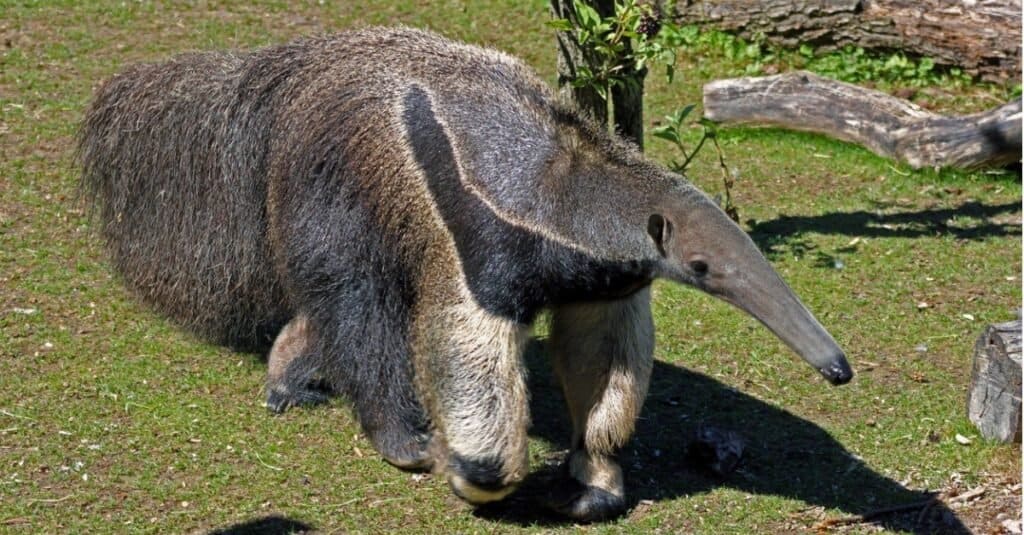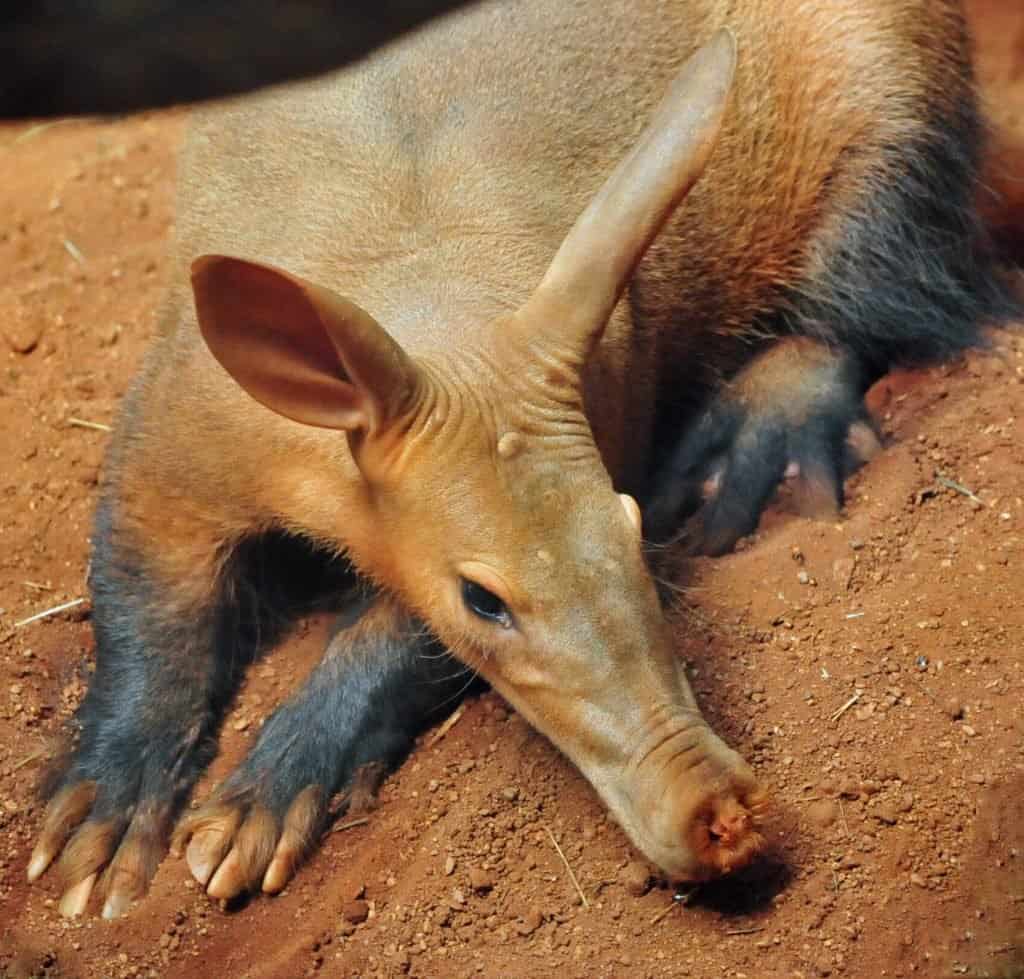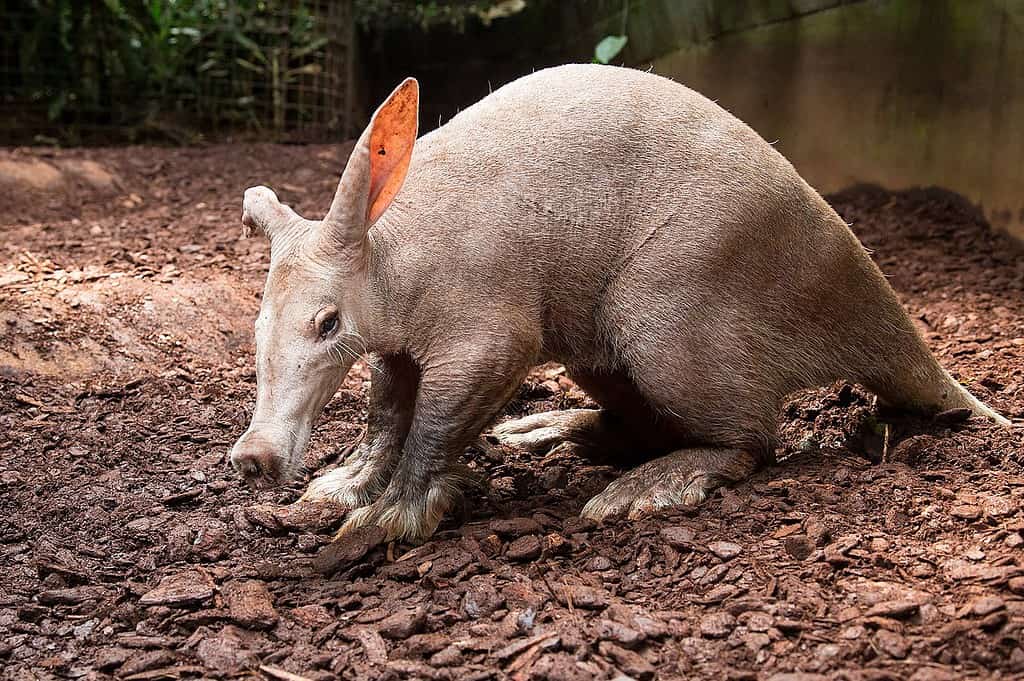Aardvarks and anteaters have a shared love of eating insects. They both accomplish their daily dining with exceptionally long snouts and very long, sticky tongues. These animals have many shared physical characteristics, which causes some confusion about their relationship. However, they have many important differences that distinguish them. So, what are their differences? Let’s take a look at aardvarks and anteaters: some of the ways these insectivores differ.
Comparing an Aardvark and an Anteater

| Aardvark | Anteater | |
|---|---|---|
| Scientific Name | Orycteropus afer | Myrmecophaga Tridactyla |
| Size | 60 – 80 kg (130 – 180 lbs) | 18-40 kg (40-88 lbs) |
| Location | Sub-saharan Africa | Central & South America |
| Habitat | savannahs, grasslands, woodlands, and bushlands | dry tropical forests, grasslands, jungles, savannahs |
| Activity | Nocturnal | Nocturnal, sometimes diurnal |
| Teeth | Yes, no incisors or canines | None |
Key Differences between an Aardvark and an Anteater

While the aardvark has teeth and the anteater doesn’t, they prefer to use their long snouts and sticky tongues to slurp up insects.
©iStock.com/Ivan Mattioli
The key differences between aardvarks and anteaters include the presence of teeth, phylogenic class, size, and behavior. Aardvarks have teeth with no incisors or canines, while anteaters do not have at all.
Let us learn more about the key differences between an aardvark vs an anteater.
Aardvark vs Anteater: Classification
Aardvarks are the only surviving species of the family Orycteropodidae. They fall within the genus of Orycteropus, derived from the Greek word orykteropous, which means digging or burrowing-footed. Their full species name is Orycteropus afer, with the afer part of the name referring to their African origin. Aardvarks were originally categorized as close relatives of Anteaters within the order Edentata. However, their unique teeth and other attributes made it clear that they are not closely related to other living mammals. Their similarities with anteaters have likely evolved as an adaptation to eating ants and other insects. Their closest relatives are other animals of African origin, like elephants, elephant shrews, and golden moles.
Also mammals, anteaters fall within the order of Pilosa within the magnorder Xenarthra, along with tree sloths and armadillos. Mammals within this clade are placental mammals who carry their young in the womb to a late stage of development. The name Xenarthra comes from the Greek words Xénos, meaning “strange, unusual” and árthron, meaning joint. This refers to their vertebral joints, which have extra articulations compared to other mammals. Anteaters are in the family Myrmecophagidae (“ant-eating”) and the genus Tamandua. Giant anteaters are the ones that commonly come to mind when referencing anteaters; their scientific name is Myrmecophaga Tridactyla.
Aardvarks vs Anteaters: Habitat and Range

Aardvarks can be found in Africa, while anteaters can be found in Central and South America.
©Heather Paul / CC BY-ND 2.0, Flickr – License
Aardvarks are native to Africa, and they now roam most of Sub-saharan Africa. This refers to the southern two-thirds of the continent, below the Sahara desert. Here they can find the appropriate habitat of savannas, grasslands, woodlands, and bushlands. They’ll adapt to any habitat that provides access to food and water with the opportunity for proper digging. The high water tables in swamp forests don’t allow them to dig deep enough for their burrowing needs. They avoid rocky terrain for the same reason, preferring sandy, clay soils. Highly skilled diggers, they create burrows that can be up to 33 ft long with multiple entrances. They always exit the burrows headfirst to sniff out potential predators upon exit.
Anteaters maintain homes in the dry tropical forests, grasslands, jungles, and savannas of Central and South America. Tamanduas as a whole find their home both on the ground and in trees, but the giant anteater is almost entirely ground-dwelling. They need large, grassy areas where ants are abundant and live beside streams and trees with plenty of vines, where ants and termites often build their nests. They maintain territories that are roughly 1 to 1.5 square miles. Anteaters are excellent swimmers. They don’t maintain permanent dens or burrows but instead choose secluded spots to curl up and rest.
Aardvark vs Anteater: Diet
Aardvarks are insectivores that feed almost exclusively on ants and termites. The only other food type that they consume is the aardvark cucumber. With strong limbs and claws capable of breaking the hard shell of termite mounds efficiently, they use their long snouts with sticky and efficient tongues to reach down and harvest the insects inside. They swallow the insects whole, and they are ground down in their muscular stomachs. They avoid eating African red driver ants and red ants. Aardvarks come out from their burrow in the late afternoon or just after sunset and forage over a home range of roughly 6 to 18 miles. They use their keen sense of smell and focused hearing to search for food in a zig-zag fashion. They normally won’t repeat a route for 5-8 days to allow time for the nests to recover before feeding again.
Anteaters eat ants and other insects quickly, flicking their long tongues up to 150 times per minute. Generally, they feed on anthills and termite mounds in less than 40 seconds for two main reasons. For one, they leave some insects to remain in the nests and repopulate as a continual food source. Secondly, they feed quickly to avoid the stings of certain insects.
Aardvark vs Anteater: Appearance
Aardvark’s long snouts surely give them a unique appearance in the animal world. These animals are roughly the size of pigs, with limbs adapted to excellent digging. Their strong, shovel-like nails are between true nails and hoofs in form. They have thick skin to protect them from biting ants. Aardvarks have teeth, but they lack incisors and canines. Unique columns of “cheek teeth” are present, which have no enamel and are made up of hexagonal prisms of dentine (bony tissue that forms the bulk of teeth below enamel). These teeth are rootless and grow continuously but don’t seem to serve a purpose. Their gizzard-like stomach helps grind up their food material when it’s swallowed whole. Their nostrils are protected when digging by fleshy tentacles and dense hairs.
Similar in appearance to the aardvark, anteaters tend to be a bit smaller. They have long snouts, and their tongues can extend longer than the length of their head. Unlike the aardvark, anteaters have no teeth at all. They’re protected by dense and long fur from insect attacks. All species except for the ground-dwelling giant anteaters have long tails for grasping objects and hanging from trees. Their stomachs are gizzard-like with hardened folds that strongly contract to grind insects. This digestive process is assisted with sand and dirt digested in small amounts while they feed.
Aardvark vs Anteater: Behavior

Aardvarks are strictly nocturnal animals.
©Theo Kruse Burgers’ Zoo, CC BY-SA 4.0, via Wikimedia Commons – License
Aardvarks are solitary and nocturnal creatures. They pair only during breeding season and prefer to find their meals in the dark of night. They have keen hearing and a great sense of smell to detect predators but poor vision. To evade danger, they will burrow very fast underground or run in a zig-zag fashion. Aardvarks can dig about a yard of a tunnel in 5 minutes but are otherwise slow-moving. If necessary, they strike with their claws, tails, and shoulders.
Anteaters are also primarily nocturnal but are diurnal in certain areas. They typically stick to their own territories, but if a dispute occurs, they will vocalize, swat, and even ride the back of their opponents. With similar senses to aardvarks, they have limited vision, but their sense of smell is excellent, and they can likely hear well too. Although they prefer to retreat if they feel threatened, they will defend themselves when necessary. An article in Wilderness & Environmental Medicine reports an incident in Brazil. A man was hunting with his dog, and they cornered a giant anteater who grabbed the man with his forelimbs, causing fatal puncture wounds. The privacy of these night-dwelling, long-snouted and solitary creatures is to be respected.
The photo featured at the top of this post is © Graham Hughes / CC BY-SA 2.0, Flickr – License / Original
Thank you for reading! Have some feedback for us? Contact the AZ Animals editorial team.






